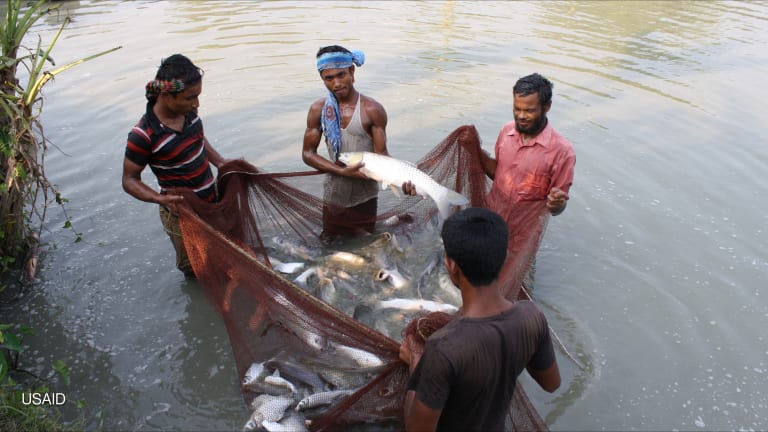
Since the Russian invasion of Ukraine, global food prices, already at record highs, have soared. Acute food insecurity has followed suit: an additional 47 million people risk starvation. Children are the most vulnerable to this escalating food crisis and the global system must be prepared to address the surge in acute malnutrition by expanding access to lifesaving treatment.
The increase in fuel and food prices coupled with a decrease in food supply is further straining the finances of families that already struggle to purchase enough food to meet their needs. History teaches us that these price shocks lead to an increase of acute malnutrition, a nutritional deficiency known as wasting due to a child’s extremely thin appearance and deterioration of their muscle mass. Globally, severe acute malnutrition kills 1 to 2 million children a year. Yet despite the presence of highly effective treatment, at best, just 20% of children who suffer wasting access the care they need.
In countries already facing severe levels of hunger and acute malnutrition, rising food prices will have devastating consequences. In Ethiopia, which sources nearly 70% of wheat imports from Ukraine and Russia, and Kenya and Somalia, which source more than 80%, the war’s impacts exacerbate an already dire situation caused by a combination of conflict and record drought.
In East Africa, 20 million people are at risk of starvation. In Syria, the impact of rising prices is felt as bread prices double. In Afghanistan, drought, insecurity, and the international pullout have driven mass hunger and malnutrition: 95% of families do not have enough to eat. And a new report warns that the global crisis will further deteriorate as conflict, specifically the war in Ukraine, continues and climate change worsens.
Fortunately, we can act now to save lives by building the capacity to manage the spike. Supply of ready-to-use therapeutic food, or RUTF, a highly effective and lifesaving treatment product, is central to this effort. Inspired by Nutella, RUTF is a nutrient-rich fortified peanut butter paste that in a matter of months can fully recover a child with wasting, helping them regain the strength to walk or fight off routine illness. It is portable and non-perishable, enabling treatment in even the most difficult and hard-to-reach contexts.
But there’s a problem. Even before the war in Ukraine, the supply of RUTF and the treatment system were inadequate to meet demand, and now, prices are increasing. With acute malnutrition on the rise, we must act urgently to stave off the worst consequences for children — here’s how.
First, increase production. According to UNICEF’s latest supply outlook, we are utilizing just 56% of the current global production capacity. We can more fully realize the production potential for RUTF by guaranteeing polled procurement, especially from manufacturers based in low-income countries, to produce enough supply for current and future needs.
Second, pre-position RUTF supply where we anticipate surges in wasting. Unlike some lifesaving commodities, RUTF has a relatively long shelf life of two years. This allows for building stores of buffer stock with little risk of waste from expiration.
We could warehouse RUTF supply in East Africa now, recognizing how the war in Ukraine and unprecedented drought are exacerbating the widespread hunger and malnutrition crisis, and enable supply to be sent to countries as needed with shorter lead times. This strategy can also provide cost savings to ensure that donor dollars are most effectively spent by ensuring that stock is already in place rather than having to rush it in emergency contexts.
Third, ensure that efforts to improve supply are matched with expanded access to care. With an increased supply of RUTF and reforms to streamline and simplify the treatment system, we can greatly expand treatment coverage and save lives.
The International Rescue Committee has long been testing a series of simplified approaches that empower caregivers and community health workers to diagnose and treat wasting with easy-to-use tools. These approaches bring care directly to children rather than requiring frequent visits to health centers that are often far away and dangerous to travel to. Evidence has shown that these approaches are just as effective as the current treatment system and more cost-effective, demonstrating the potential to transform the system to meet the needs of children and their families.
Finally, we must put in place flexible, longer-term funding for humanitarian crises. The current model funds RUTF production and distribution through emergency response, waiting until crisis hits to mobilize resources. We must do a better job of forecasting needs and directing resources before a crisis strikes.
We’re quickly running out of time to prepare for the consequences of the war in Ukraine, but if donors act now, rather than waiting for the crisis to accelerate, we can better spend each dollar and, most importantly, save more children’s lives.
The global hunger crisis is here. Donors, the United Nations system, national governments, and front-line implementers must immediately work together to save lives. We must increase the supply of lifesaving RUTF and ensure that access to this treatment is available in vulnerable communities such as countries in the Horn of Africa. In doing so we can mitigate the impacts of the war in Ukraine and minimize the deadly consequences of the surge in child wasting.









